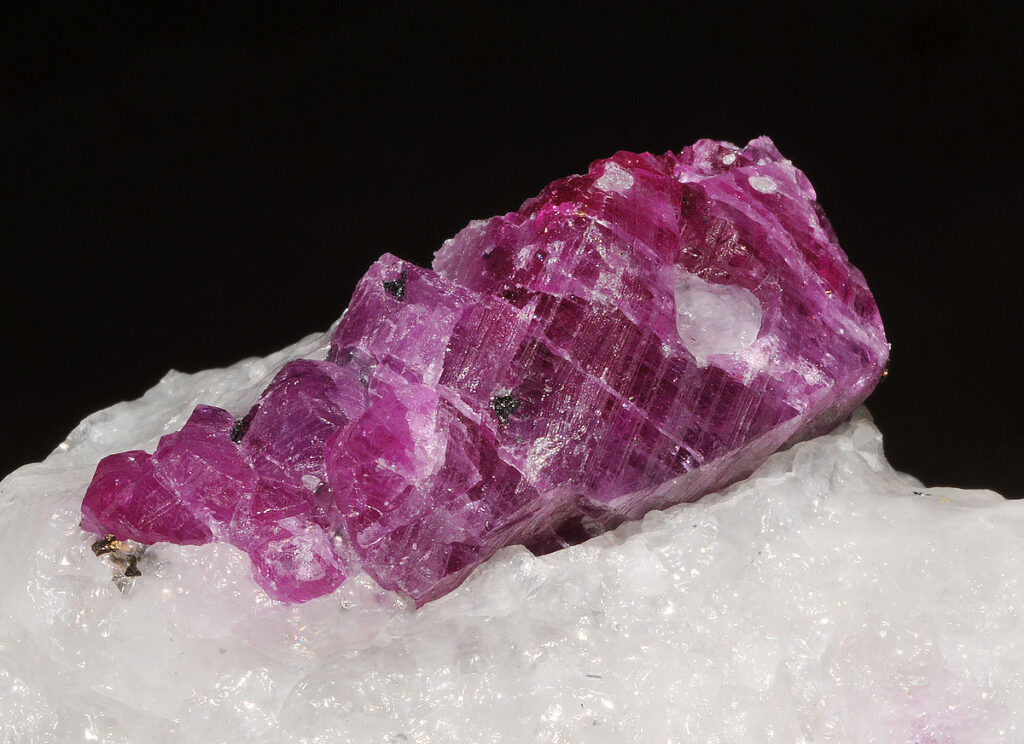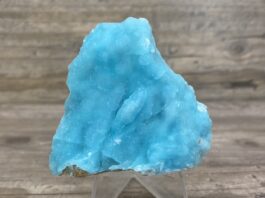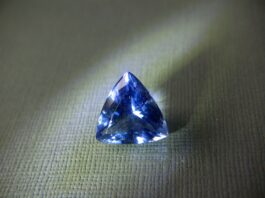Ruby is a gemstone and a variety of the mineral corundum (Al2O3) that is distinguished by its red color, which is caused by trace amounts of chromium in the crystal structure. Ruby is a very hard and durable gemstone, with a hardness of 9 on the Mohs scale, and is often used in jewelry such as rings, necklaces, and bracelets. Ruby is also known for its historical and cultural significance, with many ancient civilizations valuing it as a precious stone.

Historical uses of ruby
Ruby has a long and rich history of use in jewelry and other decorative objects, as well as being valued for its perceived magical and mystical properties. Here are some examples of historical uses of ruby:
- In ancient times, ruby was considered to be one of the most precious gemstones and was often used in royal and religious objects, such as crowns, scepters, and holy relics.
- In Hindu mythology, ruby was associated with the sun and was believed to bring good health, wisdom, and success to its wearer.
- The ancient Greeks believed that wearing a ruby would help preserve physical and mental health, and that it would protect its wearer from harm.
- During the Middle Ages, ruby was considered to have healing powers and was often used to treat various ailments.
- In the Renaissance period, ruby was valued for its beauty and was often used in jewelry, particularly in royal and noble circles.
- In the Victorian era, ruby became a popular gemstone for engagement rings and other sentimental jewelry, symbolizing love and passion.
Today, ruby remains a popular and valuable gemstone, used in a wide range of jewelry and decorative objects. It is also still associated with qualities such as love, passion, and vitality.
Physical and Chemical Properties of Ruby
Ruby is a variety of the mineral corundum (Al2O3) and is distinguished by its bright red color, which is caused by the presence of chromium in the crystal structure. Here are some of the key physical and chemical properties of ruby:
- Hardness: Ruby is a very hard and durable gemstone, with a hardness of 9 on the Mohs scale, making it one of the hardest gemstones after diamond.
- Density: Ruby has a density of around 3.99 to 4.00 g/cm³, which is slightly higher than the density of pure corundum.
- Color: Ruby is red, and the color can range from pinkish-red to deep blood-red. The intensity of the color is dependent on the amount of chromium present in the crystal structure.
- Crystal structure: Ruby has a hexagonal crystal structure, and the crystals are usually prismatic with flat, basal terminations.
- Refractive index: The refractive index of ruby is around 1.76 to 1.77, which means that it has strong optical properties.
- Birefringence: Ruby has a relatively low birefringence, which means that it does not show much double refraction when viewed under polarized light.
- Chemical composition: Ruby is composed of aluminum oxide (Al2O3) with trace amounts of chromium, which give the gemstone its characteristic red color.
Overall, ruby is a highly valued gemstone due to its striking red color, durability, and optical properties.

Chemical composition and variations
Ruby is a variety of the mineral corundum (Al2O3) and has the same chemical composition as other corundum gemstones, including sapphire. The difference in color between ruby and sapphire is caused by the presence of trace amounts of chromium in ruby’s crystal lattice structure, which give it its characteristic red hue.
In addition to chromium, other trace elements can also be present in ruby and can affect its color and properties. For example, iron and titanium can give ruby a brownish or bluish tint, while vanadium can produce a purplish-red color. In rare cases, ruby may contain inclusions of rutile needles, which can create a star effect called asterism.
Synthetic ruby, which is created in a laboratory, has the same chemical composition as natural ruby but is usually created using a different process. Synthetic ruby can be made using the Verneuil method, which involves melting and crystallizing powdered alumina with small amounts of chromium oxide to create a crystal that is then cut and polished into a gemstone.
Overall, ruby’s chemical composition is relatively simple and consists primarily of aluminum and oxygen with trace amounts of chromium and other elements that can affect its color and properties.
Formation and Occurrence of Ruby
Rubies are formed deep within the Earth’s crust under intense heat and pressure. They are primarily found in metamorphic rocks such as marble, gneiss, and schist, as well as in some igneous rocks like basalt and syenite.
Ruby formation occurs through a process called crystallization, in which minerals are transformed from a molten state into a solid crystalline form. During this process, the necessary elements like aluminum and oxygen come together to form corundum crystals, which can then become ruby if they contain enough chromium to give them a red color.
The specific conditions required for ruby formation include high temperature and pressure, as well as the presence of certain chemical elements like aluminum, oxygen, and chromium. The process of ruby formation can take millions of years and usually occurs in locations where these conditions are met, such as in areas with high geothermal activity or where tectonic plates are colliding.
The most significant ruby deposits are found in areas of metamorphic rocks, such as in the Mogok region of Myanmar, which is known for producing some of the world’s finest rubies. Other significant ruby deposits can be found in places such as Thailand, Sri Lanka, Madagascar, Tanzania, and Mozambique.
Overall, the formation of ruby is a complex process that requires specific geological conditions and can take millions of years to occur. The result is a rare and valuable gemstone that has been prized for its beauty and rarity for thousands of years.
Geological conditions necessary for ruby formation
The formation of ruby requires specific geological conditions. These conditions typically include high temperature and pressure, the presence of specific chemical elements, and certain types of rock formations.
Rubies are usually formed within metamorphic rocks, such as marble, gneiss, and schist, that have been subjected to high heat and pressure. The process of metamorphism involves the transformation of existing rocks through the application of heat and pressure, resulting in the formation of new minerals.
The specific temperature and pressure conditions required for ruby formation are typically found in areas with high geothermal activity or where tectonic plates are colliding. These areas can create the high pressure and temperature conditions required for the formation of ruby.
In addition to high temperature and pressure, the presence of specific chemical elements is also necessary for ruby formation. Rubies are composed of corundum (Al2O3) with trace amounts of chromium that give them their characteristic red color. The presence of chromium in the rock formations where rubies are formed is critical to the gemstone’s formation.
Overall, the geological conditions necessary for ruby formation are complex and require a specific combination of factors. Ruby deposits are found in limited locations around the world, making the gemstone rare and valuable.
Worldwide distribution of ruby deposits
Rubies are found in various locations around the world, although high-quality deposits are relatively rare. The most significant ruby deposits are found in Asia, particularly in Myanmar (Burma), which is known for producing some of the finest rubies in the world. Other significant ruby deposits are found in regions of Sri Lanka, Thailand, Vietnam, and Cambodia.
In Africa, significant ruby deposits have been found in Madagascar, Mozambique, and Tanzania. In these locations, rubies are typically found in metamorphic rocks such as marble, gneiss, and schist.
Ruby deposits have also been discovered in other parts of the world, such as in the United States (North Carolina), Greenland, Afghanistan, Pakistan, and Australia. However, the quality and quantity of rubies found in these locations are generally lower than those found in the aforementioned regions.
Overall, the worldwide distribution of ruby deposits is relatively limited, with high-quality deposits concentrated in a few locations in Asia and Africa. This rarity contributes to the value and demand for the gemstone in the global market.
Mining and Extraction of Ruby
The mining and extraction of rubies can be a complex and labor-intensive process. The following is a general overview of the process:
- Exploration: The first step in mining rubies is to identify potential deposits through geological surveys, remote sensing techniques, and other exploration methods.
- Mining: Once a potential deposit is identified, the next step is to extract the rubies from the ground. This is typically done through either open-pit or underground mining methods. In open-pit mining, large holes are dug in the ground to access the ore body. In underground mining, tunnels are dug to access the ore body.
- Sorting: After the ore is extracted, it is sorted to separate the rubies from the waste rock. This is typically done using a combination of physical and chemical methods.
- Processing: Once the rubies are sorted, they are typically washed, crushed, and screened to remove any remaining waste material.
- Cutting and Polishing: After the rubies are processed, they are sent to be cut and polished into finished gemstones. This is typically done by skilled artisans using specialized cutting and polishing equipment.
- Grading and Certification: After the rubies are cut and polished, they are graded based on their quality, color, clarity, and other characteristics. They may also be certified by independent gemological laboratories to provide assurance of their quality and authenticity.
The mining and extraction of rubies can be a complex and labor-intensive process that requires significant investment and expertise. However, the demand for high-quality rubies in the global market continues to make it a lucrative industry.
Applications of Ruby
Rubies are primarily used as gemstones in jewelry, but they also have a range of other applications in various industries. Here are some common applications of ruby:
- Jewelry: Rubies are prized for their vivid red color and durability, and are commonly used in high-end jewelry such as rings, necklaces, and earrings.
- Laser technology: Synthetic rubies are used in laser technology, particularly in medical and scientific applications. Ruby lasers are used for medical procedures such as tattoo removal, as well as for scientific research in fields such as spectroscopy.
- Industrial applications: The durability and high melting point of ruby make it useful in various industrial applications, such as for bearings and mechanical seals in pumps and gas turbines.
- Watchmaking: Rubies are used as bearings in high-end mechanical watches, particularly in the escapement mechanism, which is responsible for the accuracy of the watch’s timekeeping.
- Optical applications: Rubies are also used in various optical applications, such as in camera lenses and scientific instruments.
Overall, ruby’s unique combination of color, durability, and other properties make it a valuable material with a range of applications across various industries.
Summary of key points
- Ruby is a red variety of the mineral corundum, and is one of the most valuable and sought-after gemstones in the world.
- It has a hardness of 9 on the Mohs scale, making it one of the hardest minerals, and is also extremely durable and resistant to scratches and damage.
- Ruby’s color comes from the presence of chromium in the mineral, and the intensity and hue of the color can vary depending on the specific chemical composition of the stone.
- Rubies are typically found in metamorphic and igneous rocks, and are most commonly mined in countries such as Myanmar, Sri Lanka, and Thailand.
- The mining and extraction of rubies can be a complex and labor-intensive process, involving exploration, sorting, processing, cutting and polishing, and grading and certification.
- Ruby is primarily used as a gemstone in jewelry, but also has various applications in industries such as laser technology, watchmaking, and optics.
- The high demand for high-quality rubies in the global market makes it a lucrative industry, but also raises concerns about ethical and sustainable mining practices.
Ruby FAQ
- What is the difference between ruby and pink sapphire?
- Answer: Ruby and pink sapphire are both varieties of corundum, but they are distinguished by their color. Rubies are red, while sapphires can come in a range of colors, including pink. The distinction between ruby and pink sapphire can be somewhat subjective and can depend on factors such as the intensity and hue of the color.
- How is ruby formed?
- Answer: Ruby is formed under high-pressure and high-temperature conditions, typically in metamorphic or igneous rocks. The presence of chromium in the mineral leads to the red coloration of ruby.
- What is the significance of ruby in astrology and healing?
- Answer: In astrology, ruby is associated with the sun and is believed to have properties such as enhancing vitality, strength, and confidence. In healing practices such as crystal healing, ruby is believed to have properties such as promoting energy, passion, and courage.
- How is the quality of a ruby determined?
- Answer: The quality of a ruby is typically determined by a combination of factors such as color, clarity, cut, and carat weight. The most prized rubies are those that have a vivid, deep red color, with few or no visible inclusions, and are cut and polished to maximize their brilliance and beauty.
- How can I care for my ruby jewelry?
- Answer: Ruby is a durable and hard gemstone, but it is still important to care for your ruby jewelry to ensure its longevity and beauty. You can clean your ruby jewelry with a soft cloth and mild soap and water, and avoid exposing it to harsh chemicals or high temperatures. It is also a good idea to have your ruby jewelry checked and cleaned by a professional jeweler periodically.



